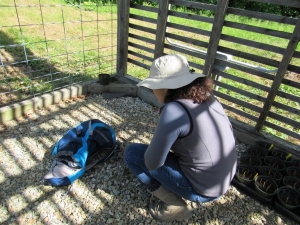You are here
No Such Thing As Too Much Garlic? Think Again!
 One of the first things my driver told me on my way to Harvard Forest from the Boston airport was that Massachusetts was in the middle of a drought. Now I thought this was odd because, looking out of my window, I saw lakes sitting on both sides of the road. Being from California I expected a slightly different view of the city when the word "drought" was used.
One of the first things my driver told me on my way to Harvard Forest from the Boston airport was that Massachusetts was in the middle of a drought. Now I thought this was odd because, looking out of my window, I saw lakes sitting on both sides of the road. Being from California I expected a slightly different view of the city when the word "drought" was used.
For the rest of the summer I would experience large amounts of cold rain, humidity, thunderstorms, high temperatures, and frizz....sometimes all in the same day (except for the frizz, that's become an everyday problem). "They call this weather," my coworkers teased.
So why am I out here so far from home? Why did I trade in my predictable warm Southern California climate for...this? Well, because I had the opportunity to do science!
This summer I've been offered the opportunity to work in the lab of Kristina Stinson. She along with my mentor Julia Wheeler and her colleagues are all looking at the effects of garlic mustard on the environment.
Garlic mustard is an invasive species of mustard plant brought to North America by the early European settlers. Since then it has managed to spread itself throughout Massachusetts and in the process it has toxified the soil with chemicals it releases through its root system.
These chemicals are known to disrupt the mycorrhizal communities in the soil that other native plants rely on in order to receive certain nutrients. Such plant species include the Acer rubrum (red maple), which is one of the more prominent trees in Massachusetts and the New England area. If the garlic mustard plant, which oddly enough stands only a few feet tall and reeks of garlic, has the potential to outcompete the giant red maple trees, then the population of red maples can potentially decrease and change the forest composition.
One solution might be to make a ton of garlic mustard pesto out of the plants, which I hear is actually quite good, but my project focuses on the effects of a garlic mustard invasion on the germination, survival, growth, and colonization of mycorrhizae on the roots of red maple seedlings. The seeds my mentor and I planted are undergoing a few different treatments. In one case the soil they're planted in was treated with garlic mustard tea, which I realize is not as appealing as pesto. A second treatment involves warming the soil in the pots on heated mats to simulate climate change effects on the soil. The third treatment is a team-up of the destructive forces of garlic mustard AND soil warming..
I can't lie and say that no plants in this experiment were harmed, because I've already had several die. But the science must go on! What I'm looking for is to see if the experiment I'm running suggest that the forest ecosystem, with regard to red maple populations, will be affected in response to global climate change and the garlic mustard invasion. Unfortunately it's too soon in the experiment to tell, but I hear there may be a paper on this, so stay tuned!






